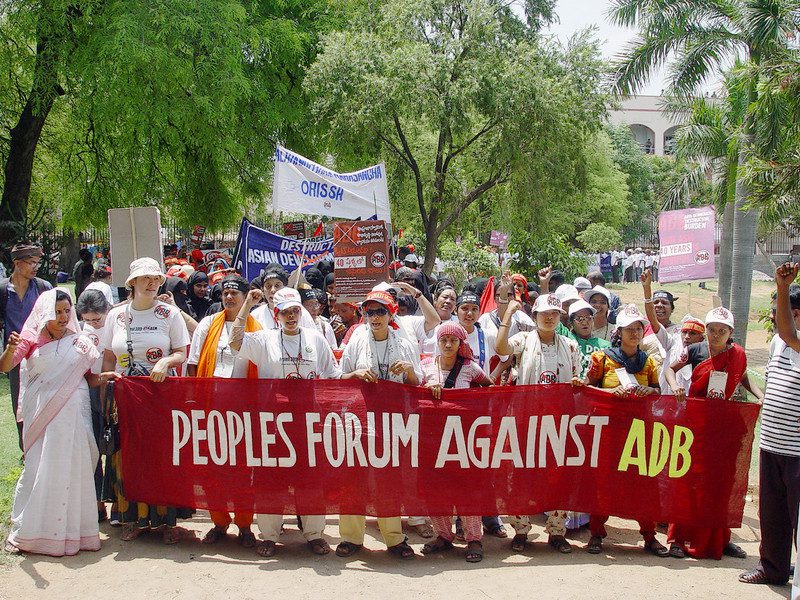The Asian Development Bank
The Asian Development Bank (ADB) is a major driver of economic development throughout the Asia-Pacific region – especially of large-scale infrastructure projects.
The bank’s headquarters is based in Manila, and was established in 1966 to promote social and economic development to countries in the region through loans and technical expertise. It comprises 67 member countries, including 44 developing countries from Asia Pacific.
The overarching goal of the ADB is to reduce poverty.
The rise of the Asian Development Bank’s power
In recent years, the amount lent by the ADB has risen steadily – doubling from USD $5.7 billion in 2005 to USD $10.5 billion in 2008.
Despite the global financial crisis, lending by the bank continues to grow.
In fact, the global financial crisis has given institutions like the ADB a significant boost. Donor governments see them as reliable channels to providing secure finance to developing countries.
At the ADB’s 2009 Annual Meeting, representatives from all member countries approved a 200% increase of the ADB’s general capital resources. This will give the bank another USD $10 billion of lending power over the coming years.
Increased funding to the ADB equals increased power – and increased impacts on people and environment. These impacts are not always positive.
Is the ADB really reducing poverty?
The bank claims that its influence has contributed to poverty reduction in Asia. The bank is basing this on the idea that the number of people living on less than $1 a day is directly linked to the number of people living in poverty. So to follow this line of reasoning – the further a person’s level of income rises above $1 a day their quality of life also improves. This link is tenuous because rising incomes can mean a decline in quality of living. An example is the Sekong province of southern Laos:
The yearly income in Sekong province was measured at USD $120 in 2003 which is well below $1 a day. But the World Conservation Union showed that the value of goods that people sourced from the forests (compared to the price of having to buy them at the market) pushed the actual level of income to USD $525 per year. In this instance the availability of forest resources adds to the quality of life by improving access to food and general health – yet doesn’t register in the $1 a day model of poverty measurement.
This example also shows that when people lose access to natural resources like forests, even if they experience a doubling or trebling of income, they can still experience a decline in standard of living. This is currently happening to people in Sekong province.
Impacts: good v bad
The impacts of the bank’s influence and decisions are experienced in different ways. So it’s difficult to categorically assert or deny the bank’s claim that infrastructure development alleviates poverty.
Evidence suggests that many bank projects have damaged the environment and undermined communities’ rights to determine their own needs and participate in decisions relating to development, leaving them worse off.
For example a six-lane highway may contribute to increased flows of goods which may raise a country’s overall GDP. Yet, the communities directly affected may be displaced from their land to make way for the new road. Pushing people deeper into poverty.
The ADB’s projects
Large-scale infrastructure projects, such as roads, hydropower dams, coal fire plants, funded by the ADB, tend to be particularly high risk in terms harmful impacts. One ADB initiative of particular concern is the Greater Mekong Subregion Program.
Since 1992, the Asian Development Bank has invested billions of dollars in the Mekong region (Vietnam, Cambodia, Laos, Thailand, Burma and China’s Yunnan province) with a vision to transform it into a single economic subregion – called the Greater Mekong Subregion (GMS).
The bank claims that the GMS initiative has contributed to rapid economic growth among Mekong nations, and therefore to poverty alleviation. But critics have questioned the success of the GMS in actually improving people’s quality of life in the Mekong.
In particular there is concern that the GMS initiative has encouraged widespread and unsustainable exploitation of natural resources through logging, transmission lines linked to hydropower projects, commercial fishing and mining. This has enormous implications for the millions of small-scale farmers and fishers in the Mekong region who depend on these resources.
Making the ADB accountable
As an international institution, the ADB is not legally bound by national or international law. The only way communities can hold the ADB to account is through its own policies which are supposed to protect those affected by its operations.
Because of the importance of ADB policies, Oxfam closely monitors their implementation and any proposed changes. The ADB’s safeguard policies are particularly important as their purpose is to prevent harmful impacts on communities and the environment.
The ADB’s Accountability Mechanism provides a recourse mechanism for affected people who have been harmed by the ADB’s projects. The Mechanism includes two arms, one that focuses on problem solving, and another that investigates the ADB’s compliance with its own policies, such as the safeguard policies.
The ADB is currently revising this Accountability Mechanism. Together with civil society partners, Oxfam is closely following the review and providing analysis and recommendations to ensure that the Accountability Mechanism provides independent, effective recourse for communities who experience harm due to ADB-supported projects.
Oxfam’s submission (April 1, 2011) on the ADB’s Consultation Paper for the Accountability Mechanism can be found here.
Oxfam’s submission (June 1, 2011) on the ADB’s Working Paper for the Accountability Mechanism can be found here.
